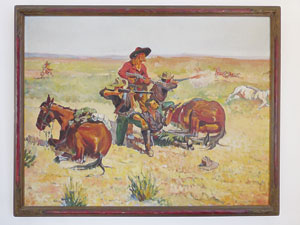
Imagine you’re an appraiser and TB sent you what appeared to be a copy of a famous painting “Caught in the Circle” by Frederic Remington (1861-1909)? TB’s painting sports a signature, which might confuse you more, signed in dark blue oil (typical of FR) “Remington.” TB writes you that this painting hung in his grandparents’ home since the 1930’s or 40’s. Then you look closer and see something painted faintly after the signature “Remington – M.F.S. 32.” When you do a zoom on your computer, you see the brushstrokes in oil are well executed, “painterly.” You suspect you need to touch, smell and see this painting in person. If the renown Western painter Remington did paint this, researching the last auction of a sale, TB may have a painting worth $5.6 million (Coeur d’Alene Art Auction 7/28/13 of Remington’s “Cutting Out Pony Herds”)
Why my assessment of TB’s painting is cautious
Painters sometimes do more than one version of a popular painting of theirs – in oils, again. And in the early 20th century “reproduction” began. They used Chromolithography, a type of colored lithograph, an early reproductive process. Remington became famous for publishing portfolios of images he either drawn or painted previously. A chromolithograph, “Antelope Hunting,” a simple print from the Remington portfolio published in 1889 in Boston by Whidden Publishing Company, in a collection titled “Sport or Shooting and Fishing,” sold for $1,250.
“A Bunch of Buckskins,” another noteworthy Remington reproduction published by R. H. Russell in 1901, also a series of chromolithographs. Today, these are often separated from the portfolio and sold as original prints. “A Bunch of Buckskins” images, originally Remington pastels, were reproduced as chromolithographs.
Some titles among the most sought after Remington prints:
- “An Old Time Trapper”
- “An Arizona Cowboy”
- “A Black Foot Brave”
- “A Northwest Half Breed”
These large chromolithographs, 20″ x 15,” are worth into the $2,000’s.
Collier and Sons, NY, also published half-tone prints in a Remington Portfolio entitled Done in the Open, from 1903. The half-tone prints, varying sizes of small dots in gray tones for black and white prints and in colored tones for colors, are not as valuable as Remington chromolithographs. They sell for $150 each at a 8″ x 12″ size. “Caught in the Circle” or the painting’s full title, “The Last Stand of Three Troopers and a Scout Overtaken by a Band of Hostile Indians,” was reproduced in this Done in the Open portfolio in 1903. At 12 ¼” x 19 ¾” (with fold), the reproduction of an oil painting became beloved.
Collier also published “Caught in the Circle” in 1908 in a portfolio of color half-tones entitled Remington’s Four Best Paintings. We see how ubiquitous “Caught in the Circle” became as an images reproduced everywhere. Which means, to me, any good art student used the reproduction as a training exercise for their own painting.
Don’t consider this “copy technique” as a farfetched, long-ago tradition. Go to Reproduction-Gallery.com, which advertises copying in oil any painting in any size, for somewhere around $500. I attempted to research which country these reproductions from Reproduction Gallery originated from, to no avail. Works by great artists have always been copied – sometimes by innocent students, to learn a technique, or sometimes by innocent fakers after the almighty dollar. Now that you can purchase every painting online without seeing it in person, my advice is to make sure you see it, smell it, and examine the whole thing, with your own eyes, before you judge the work.